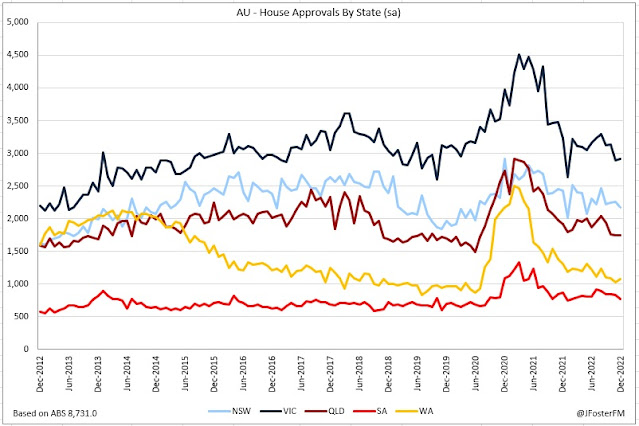Australian dwelling approvals lifted in December on the back of rises in unit approvals in Sydney and Melbourne. Approvals, however, were down more than 4% in the quarter as house approvals weakened sharply in response to RBA rate hikes and declining housing prices.
Building Approvals — December | By the numbers
- Dwelling approvals (seasonally adjusted) lifted 18.5%m/m to 16,556 in December (-3.8%yr); the market consensus was for a 1% rise, while approvals in the prior month were revised from -9% to -8.8%.
- House approvals saw their 4th decline in succession falling by 2.4% in the month to 8,989 (-12.2%yr).
- Unit approvals surged higher (58.8%) to 7,567 (8.7%yr) on the back of a wave of approvals coming through in New South Wales and Victoria.
Building Approvals — December | The details
Dwelling approvals posted an 18.5% rise in December driven by the lumpy unit segment (58.8%). However, approvals fell by 4.3% in the final quarter of 2022 incorporating declines in October (-5.6%) and November (-8.8%). Quarterly dwelling approvals (45,854) slid to their lowest level since Q3 2020. The headwinds from falling housing prices and RBA rate hikes appeared to impact approvals in the house detached segment where approvals contracted by 7.5% in Q4. Higher-density approvals were up slightly over the most recent quarter (0.9%) quarter but are flat since Q4 2021 (-0.1%).
House approvals are sliding across the nation, with falls over the quarter ranging from 3.2% in New South Wales to 11.5% in Queensland. Based on the monthly figures for December, house approvals in most states have declined by around 10% over the year, though the decline has been larger in Western Australia (-17.6%).
Smoothing out the month-to-month volatility, higher-density approvals have appeared to be more insulated from the early headwinds that have impacted the detached segment. Higher-density living fell out of favour during the pandemic and approvals in this segment did not see the upsurge that detached houses did through the economic recovery phase as the construction stimulus measures that flowed were generally directed towards boosting detached home building. The overlay of border closures further hampered higher-density approvals.
Looking at the major capitals in Sydney and Melbourne, the flow of higher-density approvals has picked up over recent months, though Sydney saw a slowing towards year-end (top panel chart). In Melbourne, higher-density approvals have been rising as house approvals have rolled over (lower panel chart).
In the non-residential segment, the momentum in approvals appeared to lift over the back half of 2022. However, these are nominal figures and so include the inflationary effects on commercial building costs.
Building Approvals — December | Insights
Detached approvals are weakening reflecting the interest sensitivity of the sector to the RBA's rate-hiking cycle. Developers may also be holding back from bringing forward new stock due to the high volume of work underway, particularly with housing prices now in a downswing phase. House approvals are down almost 40% from their 2021 peak, which will assist in easing inflationary pressures on home building costs over the course of the year. The higher-density segment appears to be holding up for the moment and could potentially improve as the uncertainty over migration dissipates post the pandemic.








